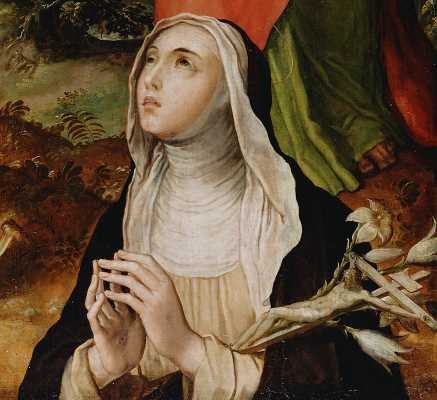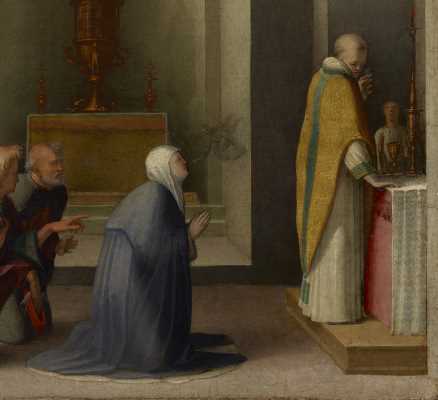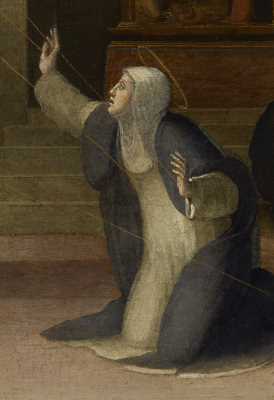 Catherine of Siena provides a great image of the spiritual life. In her book, The Dialogue, she explains that our progression is like a bridge that we must cross. The bridge is made up of stones that are the virtues. We need all the virtues to get across, but the bridge has three primary steps. If we focus on those three steps, we can cross the bridge from our lives today to lives of virtue modeled on Christ.
Catherine of Siena provides a great image of the spiritual life. In her book, The Dialogue, she explains that our progression is like a bridge that we must cross. The bridge is made up of stones that are the virtues. We need all the virtues to get across, but the bridge has three primary steps. If we focus on those three steps, we can cross the bridge from our lives today to lives of virtue modeled on Christ.
Description of the Bridge
Catherine writes of the bridge in The Dialogue. This book contains Catherine’s description of a vision she had. Her vision involves a dialog, where Catherine asks questions and God answers them. Catherine dictated the book while in ecstasy over five days. Three scribes worked to keep up with her dictation. The book is magnificent and brilliant. It is extraordinary and miraculous that she could dictate in less than a week.
The image of a bridge is a description given by God in one of the answers. Ultimately, the bridge is Jesus given to us to allow us to get to heaven.
“I told you that I have made a bridge of the Word, my only-begotten Son, and such is the truth. I want you to realize, my children, that by Adam’s sinful disobedience the road was broken up that no one could reach everlasting life… But I wanted to undo these great troubles of yours. So I gave you a bridge, my Son, so that you could cross over the river, the stormy sea of this darksome life, without being drowned.” -The Dialogue, St. Catherine of Siena
Three Steps
The bridge has three steps that must be climbed. Each step moves us closer to heaven.
“Before I show you what I want to show you, and what you asked to see, I want to describe the bridge for you. I have told you that it stretches from heaven to earth by reason of my having joined myself with your humanity, which I formed from the earth’s clay.
This bridge, my only-begotten Son, has three stairs. Two of them he built on the wood of the most holy cross, and the third even as he tasted the great bitterness of the gall and vinegar they gave him to drink. You will recognize in these three stairs three spiritual stages.” -The Dialogue, St. Catherine of Siena
Steps of the Bridge
St. Catherine provides a description of the three steps of the bridge.
“At the first stair, lifting the feet of her affections from the earth, she stripped herself of sin. At the second she dressed herself in love for virtue. At the third she tasted peace. So the bridge has three stairs, and you can reach the last by climbing the first two. But though this bridge has been raised so high, it still is joined to the earth. ” -The Dialogue, St. Catherine of Siena
Step 1: End of Vice
The soul strips herself of vice. Our first step is to stop doing the sinful things that lead us away from God. As long as we are moving away from God, we cannot move toward God.
Step 2: Love and Virtue
She fills herself with love and virtue. Once we stop our vices, we can replace them with virtue. Virtues are good habits – doing what God wills for us habitually.
Step 3: Taste Peace
She tastes peace. When we first stop our vices and start acting in virtue, it is difficult. The body resists the change and we are tempted to return to our former vices. Over time, we begin to love virtue and hate vice so we experience peace following God.
The Stones of the Bridge
St. Catherine explains how the foundation of the bridge of the is Jesus, the stones are the virtues, and they are held together by the blood of Christ. This reminds us how important the Eucharist is to our spiritual journey. The journey is only possible with the blood of Jesus.
“This bridge has walls of stone so that travelers will not be hindered when it rains. Do you know what stones these are? They are the stones of true virtue. These stones were not, however, built into walls before my Son’s passion… But after these stones were hewn on the body of the Word, my gentle Son (I have told you he is the bridge), he built them into walls, tempering the mortar with his own blood… By my power the stones of virtue were built into walls on no less a foundation than himself, for all virtue draws life from him, nor is there any virtue that has not been tested by him… He perfected the virtues and planted them as living stones built into walls with his blood.” -The Dialogue, St. Catherine of Siena
 Understanding the Steps
Understanding the Steps
The three steps are interconnected. We cannot complete the first step perfectly before we move on to the second, and likewise with the second and third. In the spiritual life, we will pass through all three steps and repeat them often as we strive for perfection.
This repetition is needed because the later steps are needed to perfect the earlier steps.
On the first step, we stop sinning. This is difficult, but it is especially challenging if we do not have something to replace the sinful behavior with. We cannot live our lives without any action. So, as we stop sinning, we need to add in virtuous actions to fill the void.
Jesus warns us about this. In Matthew 12, He describes a demon leaving a person. The demon roams the world and then returns. If it finds the person’s soul empty, it brings back seven other demons, and the person is far worse than when they started.
If we regularly commit a sin, and we stop, we need to replace that vice with something good. Otherwise, we will eventually fall back into that sin and descend much deeper into it. So, as we make progress in the first step, we need to immediately start progressing on the second step.
The same is true of the second and third step. The third step is attaining peace. This is a supernatural step. We cannot choose to be at peace our own. We need God’s help. We have free will to choose our actions with the first two steps, but the third is a gift from God.
So, what does the third step look like? Peace sounds really good, but we do not always recognize it as a gift from God. In the spiritual journey, peace is a gift to help us continue to progress.
If we have a vice, then we have become attached to a sin. It is a habit or addiction, and stopping it is difficult. We may long for the vice when we stop. Then, as we start a new virtue, we find practicing that virtue difficult. We are far from peace at this stage. We feel temptations, longings, anxiety, and fear.
In the third step, we begin to enter into the peace of Jesus. This happens as our desires change. We begin to love our virtues and detest our vices. This is essential to perfecting virtue since it is exhausting to fight against our desires.
Now, imagine how incredible this journey is. We start on the wrong path and stop. It hurts to stop our sins, but we work to replace them with good works. This is hard work because the new good behaviors are not yet habits. Then, as we continue on this path, struggling with much effort, we begin to develop the habits of doing good and begin to enjoy those habits. One day, we realize that we would hate to go back to our former life, and we know that giving up our virtues would be painful.
Through this journey, we continually hear the voice of the enemy discouraging us. The journey gets easier and easier, but we hear the enemy tell us that it will always be difficult, that we will never be happy, and that we will fail. We hear temptations pulling us back to the sins that we gave up. We must persevere for just a short time because the path to virtue will get easier. We must also trust in the grace of God to help us.
Not a Church of No 
St. Catherine’s bridge is a bridge of saying yes to Christ. It is a path to conform ourselves to the life of Jesus. We say yes to virtue and enter into the peace of Christ. It is wonderful, fulfilling, liberating and joy-filled.
Unfortunately, this is the not what the world says about the Church. We hear that the Church only says no to fun things. Chastity, fasting, poverty of spirit, sacrifice, humility, and faithfulness are ridiculed. The story the world tells is that Church only knows how to say no. The Church tells us what not to do and is nothing but a bunch of restrictive and oppressive rules.
This is completely wrong. The Church offers us one great yes. To say yes to God, yes to Jesus, yes to virtue, yes to love and yes to joy. The world looks at our faith with the eyes of the demon in Jesus’ story. If we push sin out of us, we will be empty with nothing fun in our lives. This is a lie.
St. Catherine shows us the deception in this lie. We must hope and trust in the bridge. The first steps are difficult, but they are the hardest. As we progress on the bridge, it gets easier as we grow in our love of our new life in Christ. Every step of the way, we have the grace of God ready to help us if will ask.
The path to virtue is a path to peace and joy. When we are enslaved to sin, we descend into misery and try to alleviate this misery through more sin that is less and less satisfying. When we grow in virtue, we learn to live in joy and peace, and our virtues lead to more joy and more peace far beyond what we could ever imagine. The Church is truly a Church of yes – yes to joy and yes to peace.
Hope Always
We are reminded that it is always God’s will to help us when we want His help. His grace can overcome anything, and we just need to hope and trust in Him.
“And I am God now as then: My power is not and cannot be weakened. So I can and want to and will help whoever wants my help. You show that you want my help when you leave the river behind and keep to the bridge by following the teaching of my Truth.” -The Dialogue, St. Catherine of Siena
Images:
Marco Pino (Italian (Neapolitan), before 1520 – 1587/1588), Christ on the Cross with Saints Mary, John the Evangelist and Catherine of Siena, about 1570, Oil on panel, 181.6 x 120.7 cm (71 1/2 x 47 1/2 in.)
Domenico Beccafumi (Italian, 1484 – 1551), The Miraculous Communion of Saint Catherine of Siena, about 1513 – 1515, Oil and gold leaf on panel, 28.9 x 41.3 cm (11 3/8 x 16 1/4 in.), The J. Paul Getty Museum, Los Angeles
Domenico Beccafumi (Italian, 1484 – 1551), Saint Catherine of Siena Receiving the Stigmata, about 1513 – 1515, Oil and gold leaf on panel, 28.6 × 41.6 cm (11 1/4 × 16 3/8 in.), The J. Paul Getty Museum, Los Angeles